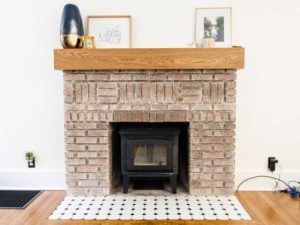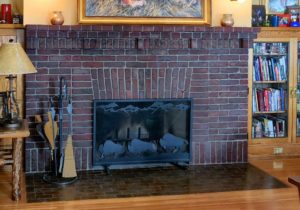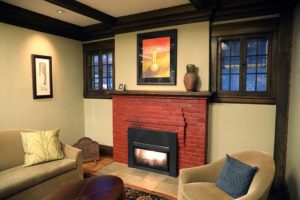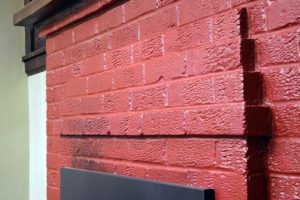Small Home Gazette, Winter 2021
Making the Best of Painted Fireplaces
For those who want to remedy a previous owner’s misdeed, there are two options: remove the paint or cover the existing paint with something that looks better.
Paint Removal: Not for the Fainthearted
Paint can be removed from bricks with chemical strippers or blasted away with abrasive grit. But even the most successful removal projects are lengthy, messy and grueling; and almost always fall short of success.

Blogger Brianna Reganskopp labors to remove white paint from rough-faced fireplace bricks in her and her husband’s 1927 house, using soy gel. (See Craft Thyme blog in Resources.)
When searching online for the best strippers for use on brick, three products are mentioned most often: Peel Away, Citristrip and various brands of soy gel stripper. They all remove paint from brick, but because brick and grout are porous and uneven, they usually must be applied and removed multiple times. When working with brick that has deep pores and crevasses, it can also be challenging to remove the stripper itself. Removal usually involves rinsing with water, and it is not easy to keep water away from the floors, wood trim and plaster walls that surround fireplaces.
In the online blog My Alternate Life (see Resources section), blogger Jordann explains how she successfully removed paint from her fireplace brick with soy gel stripper. But she was fortunate—her fireplace was small; it had only one coat of paint on it; and the bricks’ surface was smooth.

The Salt & Rook blog documents several techniques and products used in an attempt to remove the paint from this fireplace. The result was a white-washed look.
Meanwhile, married couple Katie and Pat describe their multi-week project in a three-part blog Salt & Rook (see Resources). The couple describes the strippers, tools and techniques used to remove layers of white paint from their highly-textured fireplace brick. It was sloppy, tedious, exhausting work. In the end, they got much of the paint off but not all of it, resulting in a lightly whitewashed appearance. They later admitted defeat and decided to re-paint the brick—in dark gray!
One substance we DO NOT recommend as a paint remover is lye. Lye is very caustic—it will burn skin. And when mixing a solution one must always pour powdered lye into water, not the other way around. Otherwise it will explode. Seriously.
Many years ago former Bungalow Club member Tom Thorson used lye to remove paint from the fireplace in his and his partner’s south Minneapolis home. They enclosed their fireplace in a wood frame covered with plastic sheets. Outfitted with gloves, eye goggles and a respirator mask, Tom slathered lye paste on the bricks section by section, then wiped and scrubbed it off. This removed enough paint to reveal the bricks’ rough texture but still left the fireplace looking whitewashed. So Tom applied an irregular coat of rust-colored, automotive primer spray paint to hide most of the remaining white. He followed this with a light misting of black spray paint. There were still dozens of white paint specks visible in deep pores, so he painstakingly painted each one out using a small artist’s brush.
Blasted Brick
Paint can also be blasted off of brick but this also has serious drawbacks. Hard materials such as sand should never be used, as it is guaranteed to permanently damage the bricks’ surface. Alternatives include bits of glass from recycled bottles, ground nut shells and even the use of high-pressure water vapor (see Resources). The other problem is containing the blasting media. Anything shot onto bricks with enough force to strip paint will ricochet in other directions at a very high speed.
One intrepid woman, Nina, used baking soda to remove paint from her fireplace, a process she details in her blog, 1914 Foursquare. (Actually, she used Peel Away first; then baking soda.) Nina purchased a “soda blaster’ and rented an industrial air compressor to strip paint from her bricks. She plowed through hundreds of pounds of baking soda, which stripped the paint but also thoroughly coated her living room (“…it looked like I was standing on a white sandy beach…”) and got into the home’s ventilation system, which distributed white dust throughout her house. At least the fireplace looked pretty good afterward.
Note that there are some who say that every blasting media, no matter how gentle it seems, will damage the surface of brick.
Paint the Paint
An option far tidier than stripping and/or blasting is painting over the offending paint so it looks more or less like bricks and mortar again.
If you visited the beautiful brick bungalow on Summit Avenue in St. Paul during the Bungalow Club’s 2018 home tour, you saw a lot of faux-painted brickwork. The home’s large living room fireplace was faux painted, as were the brick walls of the sunroom adjacent to the kitchen.

This fireplace, in a house that was on the Bungalow Club’s 2018 home tour, had been painted white. Artist Jeff Biggerstaff faux-painted bricks over the white paint.
The painting was done by artist, painter and wood finisher Jeff Biggerstaff. He had faux-painted bricks before, but “this was the most successful one,” he says. He explains that there is no specific formula that must be followed when it comes to re-creating the look of a brick. “It’s just an eye for color and knowing how to mix and blend the paint as you go. It’s challenging, to say the least.”
Fortunately, some of the home’s interior bricks had not been painted, so Biggerstaff was able to use them as a guide. The white paint applied by a previous owner had a glossy finish, so he first scuffed it with sandpaper and then coated it with a bonding primer. Next he painted the entire surface with a gray similar to the original grout. He then proceeded to paint the bricks individually.
To mimic the look of bricks, he used matte-finish, acrylic artist’s paints in several colors. (He has also used chalk paint for similar jobs.) To apply the paint, he uses artists brushes and sometimes a sponge to create a stippled effect. He has even used a tight-napped roller, which allows him to quickly paint the raised brick surfaces while avoiding the recessed grout lines. “I mix the paint on-site. If you’re trying to emulate brick, a lot of the time there are different colors.” Biggerstaff will do one full pass with one color, then a second pass with two or three additional colors, allowing parts of the layers underneath to show through.
A Simpler Approach

The fireplace in dentist Paul Amble’s waiting room had been painted white by a previous owner. He repainted it a deep red to help restore the room’s aesthetics.
A 1915 bungalow located on St. Paul’s Grand Avenue is, today, home to a business. St. Paul dentist Paul Amble, DDS, purchased the structure in 1989 as a new home for his growing practice. Amble’s strong appreciation for the Arts & Crafts style led him to preserve the cozy feel of the interior. For instance, the office’s reception desk features new woodwork that presents a seamless match with the rest of the bungalow’s former living room.
Opposite the reception desk is the fireplace, which anchors the practice’s waiting room. For Amble, the fireplace is a key feature.
 “A fireplace is central to making a home cozy,” Amble says, “and I feel so fortunate to have one at my business.” Many patients are anxious about a visit to their dentist, and Amble feels the fireplace and overall Arts & Crafts interior help calm his clients.
“A fireplace is central to making a home cozy,” Amble says, “and I feel so fortunate to have one at my business.” Many patients are anxious about a visit to their dentist, and Amble feels the fireplace and overall Arts & Crafts interior help calm his clients.
When Amble purchased the bungalow, the fireplace was painted white and was surrounded by white walls. Consequently, the brick façade receded, putting the visual focus on the firebox, which appeared like a small black hole in a sea of white.
“I wanted the fireplace to stand out as a strong feature of the room,” Amble says. “Because it was already painted, I went with a deep shade of red to contrast with the (now tan-colored) walls.”
 The bricks feature a strong texture that Amble wanted to preserve. It would have been faster to use a roller, but he used a brush to dab paint onto the uneven surface. It took extra time, but the results were rewarding. “My habits as a dentist who focuses on small details helped ensure that I didn’t miss any spots,” Amble relates.
The bricks feature a strong texture that Amble wanted to preserve. It would have been faster to use a roller, but he used a brush to dab paint onto the uneven surface. It took extra time, but the results were rewarding. “My habits as a dentist who focuses on small details helped ensure that I didn’t miss any spots,” Amble relates.
The room’s resulting environment features a blend of original structure and sensitive modifications that reassures visitors with a sense of tranquil quality—something that any bungalow owner would envy.
Resources
Biggerstaff Studios
Jeff Biggerstaff
biggerstaffstudios.com
“Brick Fireplace Restoration”
1914 Foursquare (blog)
“Brick Wall Creative Painting Techniques”
YouTube
“How to Remove Paint From Brick”
Craft Thyme (blog)
“My $300 Fireplace Transformation”
My Alternate Life (blog)
“Removing Paint from a Fireplace by Vapour Blasting Rather Than Sandblasting”
YouTube
“Taking Paint Off a Brick Fireplace”
Salt & Rook (blog)













